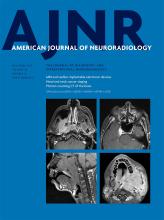Abstract
BACKGROUND AND PURPOSE: Flow diversion with the Pipeline Embolization Device (PED) for the treatment of intracranial aneurysms is associated with a high rate of aneurysm occlusion. However, clinical and radiographic predictors of incomplete aneurysm occlusion are poorly defined. In this study, predictors of incomplete occlusion at last angiographic follow-up after PED treatment were assessed.
MATERIALS AND METHODS: A retrospective analysis of consecutive aneurysms treated with the PED between 2009 and 2016, at 3 academic institutions in the United States, was performed. Cases with angiographic follow-up were selected to evaluate factors predictive of incomplete aneurysm occlusion at last follow-up.
RESULTS: We identified 465 aneurysms treated with the PED; 380 (81.7%) aneurysms (329 procedures; median age, 58 years; female/male ratio, 4.8:1) had angiographic follow-up, and were included. Complete occlusion (100%) was achieved in 78.2% of aneurysms. Near-complete (90%–99%) and partial (<90%) occlusion were collectively achieved in 21.8% of aneurysms and defined as incomplete occlusion. Of aneurysms followed for at least 12 months (211 of 380), complete occlusion was achieved in 83.9%. Older age (older than 70 years), nonsmoking status, aneurysm location within the posterior communicating artery or posterior circulation, greater aneurysm maximal diameter (≥21 mm), and shorter follow-up time (<12 months) were significantly associated with incomplete aneurysm occlusion at last angiographic follow-up on univariable analysis. However, on multivariable logistic regression, only age, smoking status, and duration of follow-up were independently associated with occlusion status.
CONCLUSIONS: Complete occlusion following PED treatment of intracranial aneurysms can be influenced by several factors related to the patient, aneurysm, and treatment. Of these factors, older age (older than 70 years) and nonsmoking status were independent predictors of incomplete occlusion. While the physiologic explanation for these findings remains unknown, identification of factors predictive of incomplete aneurysm occlusion following PED placement can assist in patient selection and counseling and might provide insight into the biologic factors affecting endothelialization.
ABBREVIATION:
- PED
- Pipeline Embolization Device
- © 2017 by American Journal of Neuroradiology












